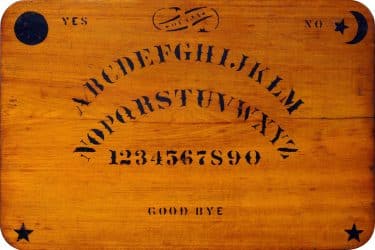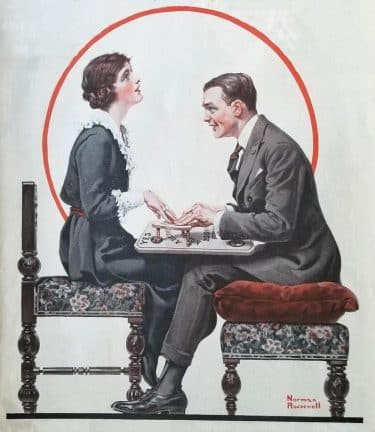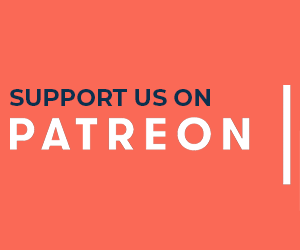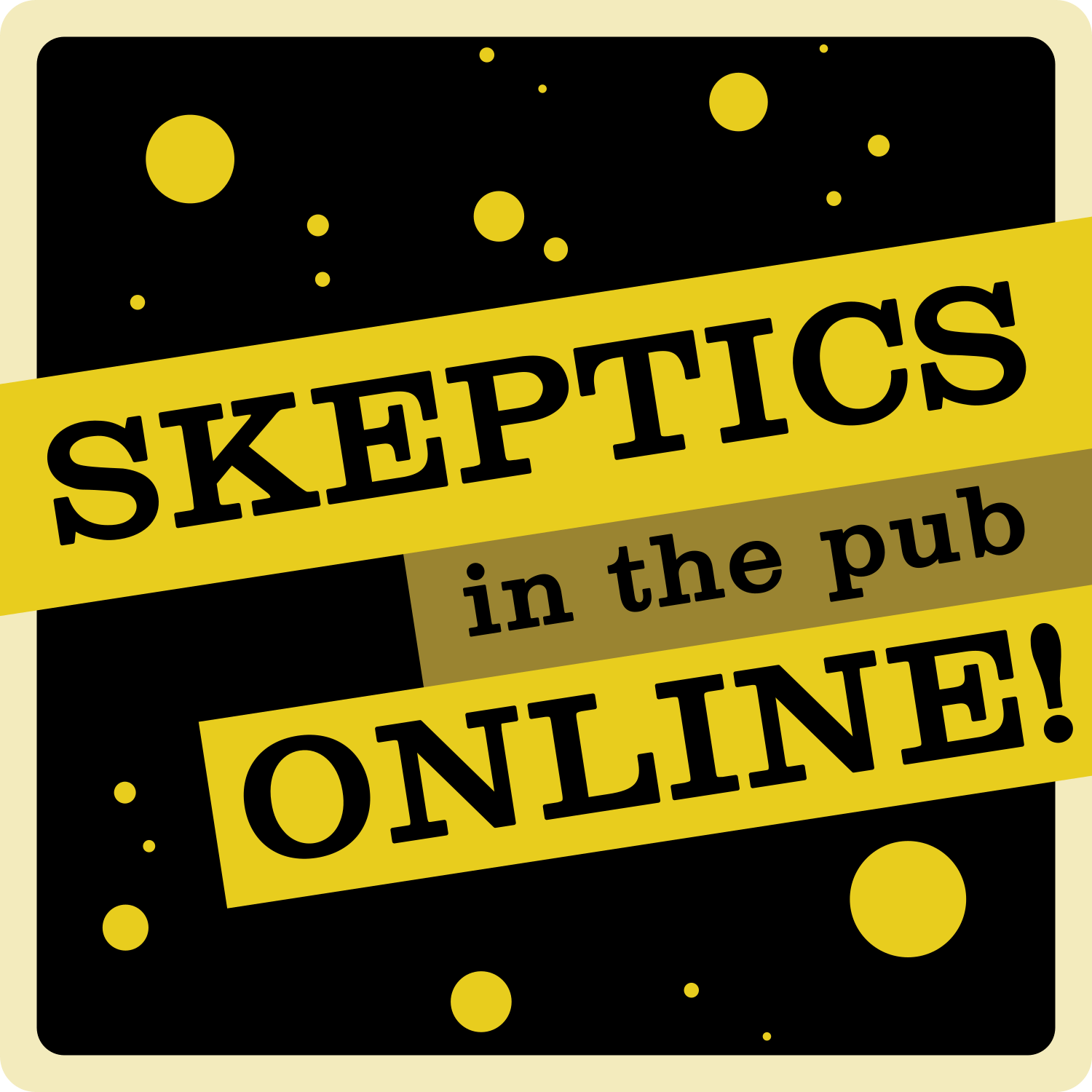We’re all familiar with the question posed by so-called spiritualists and psychics as they attempt to contact those who have passed into the other world. But the big problem is: how do you convince your marks… sorry, clients… that you really do have some amazing power? After all, not everyone falls for cold-reading, and not every psychic can do it well enough, so your target audience will naturally be limited.
What if there were some technique that seemed so remarkable, so unbelievable, that it must be supernatural? If you had that, even hardened skeptics might be convinced. In trying to find this concrete proof, the early spiritualists created an arms-race in different practices, until the eventual rise of the Ouija board in the late 19th Century.
If you’ve ever used a Ouija board, especially before you understood how they work, you’ll know that they feel other-worldly. The planchette seems to move with a life of its own, spelling words and phrases that resonate and give answers to sometimes profound and deep questions. Personally, I remember using one with a few friends as a teen and being freaked out. It might have been something to do with the darkened room and questionable smoke still hanging in the air but, for a time, I genuinely thought we had spoken to the spirit of Jimi Hendrix. Especially when some other friends, who had been away on holiday, said they too had been using a Ouija at the exact same time we had, and they too had communed with a rather busy Jimi. How freaky!
The idea of being able to talk to the dead and give answers through a medium, can be traced (at least in modern times) to the Fox sisters of New York, who became famous in the mid-19th century for their ability to hold seances with the deceased. Following the horrors of the US Civil War in the 1860’s, the relatives of dead soldiers sought some comfort in being able to speak with husbands, sons, or brothers who had so cruelly and suddenly been ripped from their lives. It was a boom-time for the spiritualists.
One spiritualist technique was table-tapping, or table-tilting. Using a hidden lever, or a concealed third party, the psychic would move the table and tap out a code to reveal letters/words, while the participants all rested their hands on the table top. But this was a bit slow and quite boring after a while, and soon someone hit on the idea of using a pencil attached to a small facsimile of the table, later removing the legs and attaching castors allowing it to move over the paper easily. With, again, everyone placing their hands on what became known as a planchette (literally French for little plank), the pencil would write answers on the paper as it moved.
Toy and novelty companies initially manufactured this planchette with its hole or clip for a pen, but unfortunately, the writing was often undecipherable – as you might expect. To counter this unintelligibility, proponents created a board which already had letters written on it and, rather than writing out the answer, they could use something to point to the letters. Initially, this was a stick or rod that could be moved by the participants’ fingers to trace out words. An article in the American Spiritualist Magazine reported:
“The method is this: I have on the table painted the letters of the alphabet, thus: On this table we place a polished little rod, rounded below and pointed on both ends; The upper side is wide for the fingers to rest, and also rough so they do not glide off. The table of course must be very smooth — I facilitate operations by putting a little powdered soap-stone on it. On this rod the fingers of the two persons sitting on the opposite sides are placed, and the rod is allowed to glide from letter to letter.”
The author added that this method proved much quicker than traditional tapping and that they were able to have “Intercourse with their spirit friends…” much faster. So much so that their spirit son agreed: “Oh dear papa and mama you have made our work so easy now”, he exclaimed from beyond the grave.
More common than a rod was to use a miniature four-legged table – a holdover from the table-tapping – which participants rested two fingers on as it moved around the marked board. The New York Tribune in 1886 reported on a craze in Ohio for the use of the table:
“I know of whole communities that are wild over the ‘talking board,’ as some of them call it. I have never heard any name for it. But I have seen and heard some of the most remarkable things about its operations—things that seem to pass all human comprehension or explanation.”
Other mediums built increasingly complicated gadgets and contraptions that spelled out letters and words using wires, wheels and levers. These dial plate machines or psychographs started to be sold in the late 1800s in specialist magazines, as different ideas spread amongst the spiritualist community. However, a marked board and a small table or rod proved simple to make, and soon the more complicated contraptions faded into obscurity.
Ouija: the board game

Around the same time, a toy maker in Massachusetts – W.S. Reed – created a version they called the Witch Board. Reed released an improved version in 1891 that combined the wheeled planchette (sans pen) with the marked board, they called it The Espirito or Revelator. Unfortunately for them, a Baltimore toymaker named Elija Bond, also came up with the idea and this time patented his invention. Along with his partners Charles Kennard and W.H. Maupin of the Kennard novelty company, they heavily promoted this version and, with its patent, it soon became the standard, with the Baltimore Sun newspaper calling it “The Wonder of the 19th Century”.
Kennard claimed that the name of the new board – Ouija – came to him after using it with a lady-friend. It spelled out O-U-I-J-A when asked what it should be called, going on to explain it meant good luck – though coincidentally, Miss Peters (the lady-friend) was wearing a locket on a chain with that word written on it.
Charles Kennard lost control of his company within a few years to a financial investor, and it would change its name to the Ouija Novelty Co. reflecting the dominance of their best-selling product. Over the next few decades, various legal battles and takeovers left William Fuld as the main patent holder, and it was his name that became synonymous with the Ouija board in the early 20th Century. The board became almost ubiquitous after the horrors of the First World war and the 1918 Flu pandemic, as grieving relatives sought to somehow remain in contact with their loved ones.
Fuld died falling from a roof in 1927 and his sons took over, eventually selling the patent to Parker Brothers in 1966, which eventually became part of the conglomerate Hasbro.
Devilish warnings
Almost from its invention, Ouija boards have been the subject of dire warnings from religious organisations. Many have accused players of meddling in satanic forces, and some publications claimed that adherents had summoned the Devil through their use. Its use in the 1973 film The Exorcist (12-year-old Regan plays with a Ouija board and meets a new imaginary friend she names Captain Howdy, who turns out to be “the devil himself”) reinvigorated its popularity, and it has become a staple of horror movies.
In November 1891, the Boston Globe reported on a woman being “CRAZED THROUGH OUIJA!”. Mrs Eugenie Carpenter, a 28-year-old “fine looking woman” wandered the streets of the city in an undressed state, exclaiming “Ouija said so, and I knew it to be true!” It seemed her husband had left her, and she had later argued with a new lover. The board had told her that he no longer loved her and would not return.
In 1920, the small California town of El Ceritto became the subject of Ouija-Mania when several women used a board to contact one of the women’s daughter, killed in a hit and run, in the hope of identifying the killer – but it soon became more ominous. The group feared they had unleashed evil spirits, which caused their children to go into trances, and they believed the spirits could only be stopped by performing a series of increasingly bizarre rituals. Soon church leaders and officials in the town stepped in and banned “spirit boards” from the town.
Several versions of the Ouija have been sold over the years, from a pink teen girls’ version in 2008, to a glow-in-the-dark board complete with ultraviolet planchette that reveals hidden messages. Many other talking boards are available online and in specialist stores. There’s even a Buffy The Vampire Slayer board, as well as many other, often beautiful, alternative designs away from the regular arc of letters and numbers on the more traditional Ouija. All use the same principle of participants laying hands or fingers on a mobile planchette, which reveals answers as it moves – supposedly independently of the contributors’ desires.
So, if it is independent, what is the cause of the movement?
Charlatans, and the ideomotor effect

There’s no doubt that frauds and charlatans would simply deny moving the planchette, even though they knew full well they were doing so. And this was certainly the case with the early table-toppers, but the beauty of the Ouija was that it could be done by anyone, and even though none of the participants consciously move it, it still moved.
Most skeptics will already be aware of the ideomotor effect. It is a term that actually predates the Ouija board, having been coined by the physiologist W.B. Carpenter in an 1852 scientific paper. The term was characterised as “the reflex or automatic muscular motions which arise merely from ideas associated with motion existing in the mind, without any conscious effort of volition.”
There are many articles, and YouTube videos available that can explain the effect if you wish to check further, but I would urge skeptics to try the board for themselves. It is a fascinating psychological tool and gives an insight into how we can so easily fool ourselves with something so simple.
Is it an almost unconscious movement made by us, especially when muscles are under stress of trying not to move? Or could it really be the Devil? After all, he would want you to think it wasn’t him, wouldn’t he…



